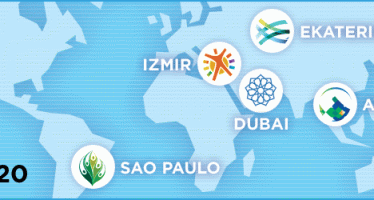Don’t Expect Miracles from the Multilaterals
by Otaviano Canuto

Washington: Inter-American Development Bank
Latin American and Caribbean economies need help, but organisations such as the IDB are also stretched thin.
With Latin America and the Caribbean potentially facing years of difficulties due to the pandemic and related economic crises, attention has shifted to what multilateral institutions like the International Monetary Fund (IMF) might do to help. There’s no doubt such bodies can play a crucial role in preventing another lost decade in the region. But they will also face limitations because of capital constraints and other factors.
The need is clearly acute. Latin America and the Caribbean remain the epicentre of the global pandemic, currently accounting for more than 43 percent of global deaths. There has been a surge in Covid-19 fatalities in Brazil, Mexico and other countries in the region. And GDP declines in the second quarter of 2020 have revealed how severe an impact Covid-19 has had on local economies.
As the last-resort liquidity provider, the IMF has so far doubled access to emergency funding, and provided more than $5bn of total financing to 17 countries in the Caribbean, Central and South America, mainly through its Rapid Financing Instrument (RFI).
But when it comes to full-fledged financing deals, one must distinguish between three country categories.
“But while the IMF has some remaining lending space, development banks must deal with limitations because of capital constraints.”
A first tier includes countries that display strong balance sheets on fiscal and balance-of-payment dimensions, and have access to the Flexible Credit Line facility, designed not to be withdrawn except in extreme circumstances. That serves as positive stamp and a low-cost insurance. Mexico, Colombia, and now Chile and Peru, are in this category. This precautionary lending line was expanded to $107bn.
A second category includes countries that were already facing external finance difficulties prior to the pandemic, such as Argentina, Ecuador, Honduras and Jamaica. Argentina just restructured $65bn in debt held by private creditors. Now it faces renegotiation of its $70bn debt with multilateral institutions, including $44bn to the IMF. The only possibility is a new roll-over programme, which Argentina has already requested.
Ecuador has also returned to the IMF after its own debt restructuring with private creditors, while Honduras and Jamaica have recently reached agreements with the fund. It is noteworthy that the accord with Jamaica accepted a reduction in its primary surplus as a counterpart to higher public social spending. Those are clear changes from past practices.
There is a third cohort of countries, with some that are already trying package negotiations and others so far not in need of IMF support. As the pandemic and the economic crisis continue to unfold, it is probable that some members of this group will join the second tier.
Multilateral and regional development banks, in turn, have all sped-up their assistance and disbursements for countries to spend on health and social protection systems. This makes money arrive faster by (among other things) approving immediate disbursement projects. For some countries that did not have access to the IMF’s emergency facilities because of lack of a minimum agreement, the banks were the only resource immediately available.
But while the IMF has some remaining lending space, development banks must deal with limitations because of capital constraints. The IDB has prioritised the poorest countries in the region. A capital increase of the World Bank was agreed in 2018, but not implemented.
For the coming year, it will get harder for multilateral banks to maintain or expand the disbursement volume. That is unfortunate, given their relevance to support economic recovery, and as cross-pollinators of knowledge.
No one-size-fits-all
Covid has been a tragedy for the region, and not only in terms of human lives: income concentration and higher public debts will be part of its legacy. And it left naked the region’s shortcomings on public health expenditures, degrees of formalisation of labour occupation, and lack of digitalisation of government functions.
This gloomy picture contains a diversity of country conditions — which means the support from multilateral institutions must vary accordingly.
Latin America as a whole is expected to suffer a GDP downfall of above 8.5 percent in 2020, only partially recovered by a positive four percent average growth rate in 2021. It is worth recalling that the shrinking of per-capita income in the region follows a period of lacklustre growth. The IMF’s World Economic Outlook update in June showed Latin America as the worst economic performer of all developing-country regions, and that is not expected to change in future forecasts.
Among the larger economies, Argentina, Mexico and Peru are poised to exhibit two-digit GDP declines, followed closely by Ecuador, while projections for Brazil, Chile and Colombia show negative growth rates in the range of minus-five to minus 7.5 percent. Uruguay is the only country in this group expected to recover its 2019-level GDP by the end of 2021. Venezuela is a tragedy apart.
Such differences reflect a range of factors, from domestic conditions prior to the virus to how the pandemic has affected them, and policy responses. Countries have taken different approaches, from “let it follow its course” (Mexico, Nicaragua) to stringent mobility restrictions (Colombia, Chile and Peru). Then there are the half-hearted and unco-ordinated local shutdowns in Brazil. Many are planning or executing re-openings, while infections and deaths are declining but still present.
Economic shocks from abroad also affected countries differently. Oil exporters felt the impact of the barrel’s price drop, while Brazil and Argentina have benefitted from China’s demand for agricultural goods. While falling tourism has hit the Caribbean, remittances were less disappointing for Central America and others, helped by the US government income transfer to its residents.
Policies of “flattening the recession curve” — including income transfers to citizens and credit to companies —have played a role, mitigating local shocks at the cost of raising public debt. Brazil and Peru had the largest income transfer schemes, while Chile prioritised credit to firms; Mexico opted for neither.
In Brazil, the resources transferred to 67m citizens as emergency aid in the first half of the year outweighed in value the whole decline in wages, a major factor behind the lower-than-expected economic recession. But debt-to-GDP is forecast to reach close to 95 percent by the end of the year. While the federal government managed to cross the storm by resorting to short-term funding, fiscal challenges will be taller at the end of the crisis period.
Despite this variety of country situations, all face the possibility of a lost-growth decade. Tackling chronic problems in infrastructure, education, inequality, governance and security will be of the essence, while coping with the immediate Covid-19 legacy. Strengthening multilateral banks’ capital structures would be of great help.
This article first appeared in Americas Quarterly.
You may have an interest in also reading…
Expo 2020: Selecting the Host City
Brazil, Russia, Thailand, Turkey, and the United Arab Emirates have all officially bid to host Expo 2020 by the 02
A Memorable Faux Pas: Warren Buffett Gets His Facts Wrong
Billionaire investor guru Warren Buffett has come to the defence of the American Dream – the promise of intergenerational upward
A Passion for Inclusivity and the Arts: Meet the Chief Exec of an Islamic Bank
Mufaddal Idris Khumri, CEO and managing director of the Maldives Islamic Bank, has deep expertise in the sector… Mufaddal Idris


















































































